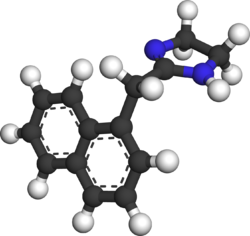 | |
 | |
| Clinical data | |
|---|---|
| Trade names | Clear Eyes, Cleari, Naphcon-A, Rohto |
| AHFS/Drugs.com | Monograph |
| Routes of administration | Ophthalmic drug administration, nasal administration |
| ATC code | |
| Legal status | |
| Legal status |
|
| Identifiers | |
| |
| CAS Number | |
| PubChem CID | |
| IUPHAR/BPS | |
| DrugBank | |
| ChemSpider | |
| UNII | |
| KEGG | |
| ChEMBL | |
| CompTox Dashboard (EPA) | |
| ECHA InfoCard | 100.011.492 |
| Chemical and physical data | |
| Formula | C14H14N2 |
| Molar mass | 210.280 g·mol−1 |
| 3D model (JSmol) | |
| |
| |
| | |
Naphazoline is a medicine used as a decongestant, and a vasoconstrictor added to eye drops to relieve red eye. It has a rapid action in reducing swelling when applied to mucous membranes. It is a sympathomimetic agent with marked alpha adrenergic activity that acts on alpha-receptors in the arterioles of the conjunctiva to produce constriction, resulting in decreased congestion.
Contents
- Medical uses
- Nasal administration
- Ophthalmic drug administration
- Side effects
- Nasal administration 2
- Ophthalmic drug administration 2
- Contraindications
- Pharmacology
- Chemistry
- Society and culture
- Illicit use
- References
It was patented in 1934 and came into medical use in 1942. [1]
